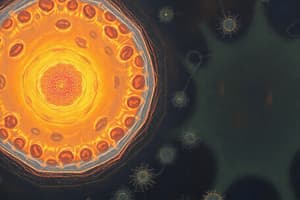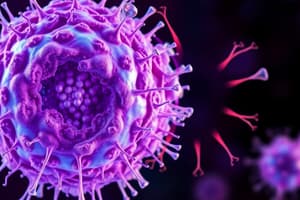Podcast
Questions and Answers
What two scientists are credited with proposing the unified cell theory?
What two scientists are credited with proposing the unified cell theory?
Matthias Schleiden and Theodor Schwann
Describe the key difference between prokaryotic and eukaryotic cells.
Describe the key difference between prokaryotic and eukaryotic cells.
Prokaryotic cells lack a "true" nucleus, while eukaryotic cells have a "true" nucleus containing their genetic material.
What is the function of ribosomes in a cell?
What is the function of ribosomes in a cell?
Ribosomes synthesize proteins, which are essential for various cellular functions.
Why are microscopes essential for studying cells?
Why are microscopes essential for studying cells?
Signup and view all the answers
What is the significance of the plasma membrane in a cell?
What is the significance of the plasma membrane in a cell?
Signup and view all the answers
Flashcards
Microscope
Microscope
An instrument that magnifies small objects to study cells.
Cell Theory
Cell Theory
Theory stating that all living things are made up of cells and new cells originate from existing cells.
Common Cell Components
Common Cell Components
Four structures all cells share: plasma membrane, cytoplasm, DNA, ribosomes.
Prokaryotes vs. Eukaryotes
Prokaryotes vs. Eukaryotes
Signup and view all the flashcards
Micrographs
Micrographs
Signup and view all the flashcards
Study Notes
Cytology
- Animal cells are units of composition and function in living organisms
- The invention of the microscope by Leeuwenhoek in 1591 revolutionized biology, allowing observation of tiny organisms like bacteria, yeast, and blood cells.
- A cell is the smallest unit of a living organism, whether single-celled (bacteria) or multicellular (humans).
- Cells vary in size; most are not visible to the naked eye.
- Microscopes magnify objects, allowing detailed study of cells. Images produced by microscopes are called micrographs.
Cell Structure
- Cells are the basic building blocks of all organisms
- Micro- is a prefix meaning "small"
- Scope is a suffix meaning "to look at"
- Micrograph is a photograph taken through a microscope
Cell Theory
- Matthias Schleiden and Theodor Schwann developed the unified cell theory.
- This theory states that all living things are composed of cells.
- The cell is the basic unit of life.
- New cells arise from existing cells.
Basic Structure of the Cell
- All cells share four common components:
- Plasma membrane: Outer layer separating the cell's interior from its environment
- Cytoplasm: Jelly-like substance inside the cell where other components are found
- DNA: Genetic material of the cell
- Ribosomes: Synthesize proteins
- Prokaryotic and eukaryotic cells differ significantly in structural organization.
Prokaryotic vs. Eukaryotic Cells
- Prokaryotic cells (e.g., bacteria, archaea) are predominantly single-celled.
- Eukaryotic cells (e.g., animal, plant, fungi, protists) are typically multicellular and more complex, containing a nucleus.
Studying That Suits You
Use AI to generate personalized quizzes and flashcards to suit your learning preferences.
Description
Test your knowledge on the fundamental concepts of cell biology with this quiz. It covers topics such as the unified cell theory, differences between prokaryotic and eukaryotic cells, and the role of ribosomes and plasma membrane. Perfect for students aiming to reinforce their understanding of cellular structure and function.




